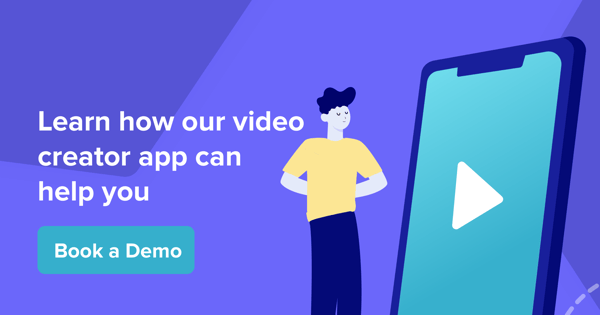Whether you’re revamping the entire candidate journey or looking to humanize key touchpoints, personalized video can play a key role in helping you achieve your recruitment objective.
Imagine that you’ve applied for roles at two different companies. You thought you were in with a good chance, but to your disappointment, you wake up one morning to find rejections from both organizations in your inbox.
With a sinking feeling, you click on the email from company A. It’s short, straight-to-the-point, and has plainly been automatically generated.
Dear [candidate 00406], thank you for applying to [position] at [company]. Unfortunately you have been unsuccessful at this time but we will keep your application on file should another position become available.
And that’s it. Crushed, you open the email from company B. There’s a note and a link. You click on it and a video begins playing. It’s someone from the company’s talent acquisitions team, talking casually to the camera while sitting cross-legged in a leafy courtyard. She begins by assuring you that you can reapply at any time.
“I know how hard it can be when things don’t work out as you expected. Try not to take it personally; for some roles we receive many applications and it might be that you just need to keep on trying to be successful. It’s also worthwhile reflecting on the process and identifying where you think you could improve for next time. Good luck!”
Which message would you rather receive?
As the second message shows, video can be used to improve the candidate experience in one of the most emotive and difficult areas, the rejection. But with many other touchpoints throughout the recruitment process and the understanding that CX actually starts at attraction, not application, the value of video personalization is endless.
We spoke to Karly George, Principal, Candidate Engagement at global resources company BHP, and Andrew Sullivan, Managing Director at recruitment consultancy Sullivan Consulting, to learn how they’ve used video to optimize the candidate experience.
Using video to humanize the candidate experience
Applying for a role is a rollercoaster that can run the whole gamut of human emotion, from hope and elation to disappointment and discouragement.
Unfortunately, many companies fail to engage emotionally with job candidates. While automation in recruitment can supercharge efficiency, the risk is that communications can feel, well, robotic.
“When a candidate receives an automated email, it feels like it’s been written by a machine,” says BHP’s Karly George. “It doesn’t feel like there’s any person or any connection there.”
Karly’s team is working to humanize the experience by embedding videos into candidate communications with hints and tips on the recruitment process, along with information about what’s going to happen next. For example, if a candidate has progressed to the interview stage, they’ll receive a video featuring Nick from the Melbourne talent team, who provides a series of helpful tips on how to ace a virtual interview.
Ultimately, candidates want clear, concise and frequent communications throughout the recruitment process. “We need to get better at telling people about the process,” says Karly. “How long things are going to take, why delays are happening; I think candidates are fine with a delay, so long as they know what’s going on.” But whenever there’s an opportunity to replace system-generated text with a video message, Karly’s team will take it.
Rejection messages is one of those opportunities. BHP receives approximately 600,000 applications per year for 15,000 roles, meaning the company sends out an eye-watering 585,000 rejections to candidates annually.
Karly’s team has focused on humanizing and softening the rejection while making it as transparent as possible – and they’ve found that incorporating a video into the automated process makes a world of difference. Rejected candidates see a human face, and the message is delivered with a mix of empathy and encouragement.
Expanding your candidate pool with video
Video job ads are seen by a lot more people than traditional text-based advertising. In fact, videos are shared 20 times more than any other type of content, and job postings with video have a 34 percent greater application rate than postings without videos.
Video advertising has the potential to greatly expand your talent attraction capabilities, bring more candidates into your pipeline and subsequently improve the quality of your hires. This all reflects back on your own role and sets you up for success.
Sullivan Consulting’s Andrew Sullivan says video job ads were met with initial scepticism in his home state of South Australia. “People were using traditional media to advertise vacancies in the market. Incorporating videos was a foreign concept – people said it was unproven, and wouldn’t last.”
Today, Sullivan Consulting has the largest Facebook following in Australian recruitment and has racked up an incredible 2.2 million views over 250-plus videos in four years.
“Creating video job ads may feel daunting at first,” says Andrew, “but it gets easier the more videos you produce.” He recommends using a similar look and feel across videos, and focusing on accuracy and brand consistency. Like the talent team at BHP, Sullivan Consulting complements its job ads with videos featuring job-seeking tips and advice for both candidates and employers.
Increasing diversity through representation on video
BHP has a goal of achieving gender balance among its employees by 2025 and increasing indigenous participation across all operations globally. The challenge is to reach out to target groups and encourage them to consider a role in mining.
“A lot of people find that first step [the application] really daunting,” says Karly. “And prescriptive job adverts don’t help. They’re generally seen as a shopping list and many people read them like that.”
The solution was to bring BHP’s job adverts to life with the use of videos that included strong representation of the groups the talent team wished to target.
“If you can’t see it, you can’t be it,” says Karly. “If we can show potential candidates videos featuring BHP employees who look like them, they’ll form a connection and think ‘Oh, actually, they’re just like me – maybe I could do that job; maybe I could apply’.”
Tracking return on investment (ROI) of video
Andrew says the value of video advertising in recruitment can be measured by tracking likes, shares and comments, along with new work, referrals, and word of mouth. “Job videos reduce the recruitment spend for clients by providing measurable data and results,” he says.
The two metrics used by the BHP talent team to measure candidate engagement are a survey for all candidates (both successful and unsuccessful) who reach the interview stage, and measuring sentiment by tracking positive and negative responses to job posts on social media.
And what do these metrics show them? That video not only is improving the candidate experience, but it’s playing an important role in helping talent and recruitment teams meet their objectives.
Want to explore how personalized video can help you optimize your candidate experience? Get in touch with VideoMyJob to book a free demo today.
.png?width=200&height=50&name=Untitled%20design%20(21).png)





